I usually interact with vehicles I drive by touching some surface inside said vehicle. Yet when I twirled my finger in the air or waved my hand, the BMW 750i xDrive knew exactly what to do.
The Bavarian Motor Works has a reputation for jamming all sorts of technology into its vehicles, and the 7-series is where new ideas first enter production. As a result, this vehicle bristles with bits and bytes, not all of which .

First impressions
BMW’s handsome sedan lines may be most apparent on the 7-series, thanks in part to its long hood and wide stance.
There’s a touch of mystery to the colour on my Carbon Metallic Black tester; it seems dark blue when you look at it up close.
Look at the B-pillar when the front door is open and you’ll see the words “Carbon Core.” This refers to the composite of materials used to make the car: aluminum; ultra-high-tensile steel; and carbon-fibre-reinforced plastic (CFRP). BMW claims this material helped shave 85 kg of weight from that of the previous generation of the 7-series.
Interior
If the exterior doesn’t win compliments, oohs and ahs, the interior will certainly do the job. Stitched Cognac Extended Nappa leather combined with wood and metal accents throughout the cabin make a stunning first impression.
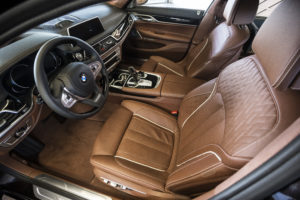
image courtesy BMW
Look up and you’ll see the Anthracite Alcantara Roofliner, consistent with the cover for the power moonroof. If you find yourself running your fingers along all these surfaces, you won’t be the first to do so.
Infinitely adjustable front seats are heated and cooled at a passenger’s whim. That whim can involve having both systems going at the same time (maybe that’s a little too much luxury, BMW?). Heated surfaces include the seats, steering wheel and armrests.
Both front seats offer massages. Massage options run off the centre touchscreen, though you can start the back- and bum-rub using buttons on the doors by the seat position memory buttons.
The rear seats aren’t quite as tricked out, though a version of the 7-series is available with seats like those found on aircraft in business class. (If all of this doesn’t do it for you, a BMW representative assures me that the company welcomes customization requests.)
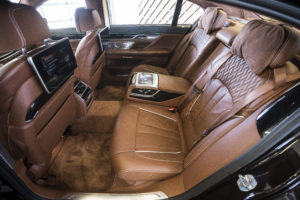
image courtesy BMW
In my tester, the optional Executive Package ensures all passengers enjoy soft close doors (and trunk) and climate comfort laminated glass all round. Rear seat passengers also get side and rear sunshades, controlled using switches in the doors beside the window lift control.
Ambient lighting goes beyond the piping throughout the cabin. Even the speakers for the Bowers & Wilkins Diamond Surround Sound System, nestled behind curved drilled metal coverings, glow softly. About that sound system: 16 speakers, 1,400 watts, tweeters made from synthetic diamonds. And it sounds that good.
Hockey bag test
The trunk easily accommodated my bag lengthwise, and I could have slid (squeezed, perhaps) another similarly-sized bag in beside it. The issue here is that that rear wheel wells intrude significantly onto the floor of the trunk. The butt ends of my sticks poked through the rear-seat passthrough, just above the pull-down armrest. (This vehicle does not ship with fold-down rear seats.)
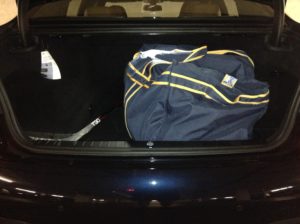
BMW includes two “close” buttons accessible when the trunk list is open. One does just what it’s supposed to. The other closes the trunk and locks the vehicle, all in one button press. That’s a thoughtful touch.
In-cabin technology
The 750i has more screens in the cabin than I do on my desk. Anybody who knows me instantly realizes that’s saying something. There’s no way to go through all the 750i’s technology features here, but I’ll do my best to cover the obvious things, and some features you wouldn’t realize are there.
The massive screen in the middle is, in this vehicle, now a touchscreen. That could come in handy, but I’ve grown used to BMW’s standard controller, a combination dial/button/joystick/touchpad. BMW was a holdout against touchscreens, and its iDrive controller system is still one of my favorites. That said, BMW claims some of its customers want touchscreens, and I guess there’s nothing wrong with another way to interact with the car’s systems (on top of voice control, the touchpad that forms the top of the iDrive controller, buttons on the steering wheel…).
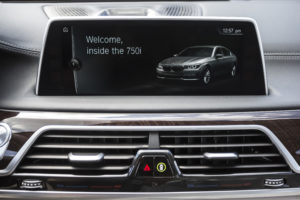
image courtesy BMW
Sticking with the topic of redundancy… Want to adjust the volume coming from the premium Bowers & Wilkins sound system? There’s the old-fashioned volume knob near the driver. The steering wheel sports volume up/down buttons. Or you can point your finger at the touchscreen, move it in a circle, and have ceiling-mounted sensors detect your gesture. Draw a circle clockwise, and the volume goes up. Draw counterclockwise and you turn the sound down. Either way, the screen displays a popup to show that it recognizes the gestures, and the system reacts appropriately.
The system offers several other gesture controls, including a two-fingered point that you can configure to perform your choice of action. (I set this gesture to mute and unmute the stereo.) My favorite gesture: I could disregard an incoming phone call by “swiping” my whole hand from left to right in front of the touchscreen, using a motion similar to a backhand slap, which could theoretically capture a driver’s first reaction to certain callers.
BMW provides this handy demo video so potential buyers get a feel for gestures work.
Rear-seat passengers aren’t left out of the electronic fun. Screens mounted on the backs of the two front seats let passengers control the infotainment system too. The setup might remind them of airplane flights, if it weren’t for the generous size of these screens dwarfing anything they might see in economy class.
These aren’t touchscreens, by the way. A remote control sits in the pull-down armrest. Flick the “L-R” switch at the bottom of this remote to correspond with the screen in front of you and you can interact with the screen in much the same way front seat passengers can use the iDrive controller and buttons available to them.
Before rear-seat passengers can dig the remote control out of the armrest, they will find a removable Samsung Android-based tablet staring up at them. Will they forget about those screens mounted in front of them?
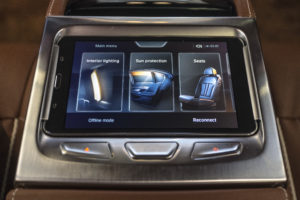
image courtesy BMW
The tablet can be used in its docking station or held in one’s hand. It’s linked to the car using one of the wireless protocols available (Bluetooth, or the 7’s WiFi hotspot, I’m not sure which). This tablet offers infotainment controls, climate controls, lighting, navigation, and so forth. The layout is similar to that on the dash-mounted touchscreen.
The ability of rear-seat passengers to adjust the front seats might drive front-seat passengers to disable rear-seat electronics, much like parents disable rear window buttons to keep bored kids from driving them nuts.
Climate controls sit on the back end of the front seat armrest. Cold or hot air comes from not just vents in the armrest but also vents in the B-pillar. Other controls, like a CD slot and power outlets, sit below these climate controls. I found these other controls impossible to see without bending down, and even then they were too recessed to be easily visible.
In case the 7 doesn’t yet have enough screens for you, there’s one more included standard on the Canadian market: the BMW Display Key. This fob, in addition to locking and unlocking the 7, lets drivers check whether the 7 is secured, current time, fuel remaining and a few other things.
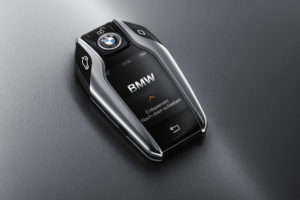
image courtesy BMW
I was initially shown this key in the 7’s inductive charger, located in the central armrest. The inductive charger works on phones that accept inductive charging too, and the space is large enough to accommodate today’s larger “phablet” phones. Other types of phones or devices can get a battery top-up from USB ports or other power ports.
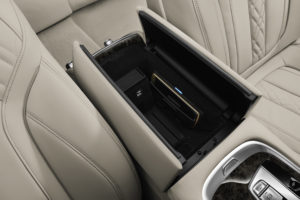
image courtesy BMW
I don’t think BMW wants drivers to hang pine-tree-shaped air fresheners from the mirror. That must be why the 7 includes an ambient air package. You install two cartridges containing pleasant scents in a glovebox-mounted receptacle, then choose one or the other using the “Ionic” controller in the climate control cluster. It’s a subtle feature, a step up for Febreze-toting motorists. The box I had contained four choices. BMW offers refills when they reach their end of life, said to be about six months.
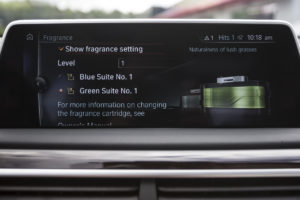
image courtesy BMW
Tracking driving dynamics, changing drive modes, even surfing the Internet using the 7 as a hotspot are just a few of the other features this 7 offers. Menus that are deep, if well-organized, could keep owners discovering new features for about as long as they own the car.
Driving
Accelerate to about 10 or 11 km/h and the seat belts tug gently. I guess it’s the 7’s way of saying “safe travels.”
This seems to be the right way to introduce the fact that power in my tester came easily to the wheels thanks to the 4.4L V8 goosed by BMW TwinPowerTurbo Technology to produce 445 hp. I had quick acceleration in the few instances when I needed it, but I preferred to let the car purr along on highway at nearly unnoticeable road noise levels. Ride quality overall? I started telling people the 7 is a short-wheelbase limo.
xDrive makes sure power goes to all four wheels, while an eight-speed transmission keeps shifts almost unnoticeable. You can do more than notice shifts if you take control using the shift lever or paddle shifters to bustle the 7 through the gears yourself.
The 7 may sport more cameras than screens, and that’s saying something. The obvious rear-view camera is supplemented by the front mirror camera, as well as cameras pointing front and back mounted on the exterior mirrors, plus a camera or two poking out of the front grill.
The 7 provides views of individual cameras. It also stitches together views from several cameras to provide a top view, 3D view and panorama view. When parking, the 7 helpfully places translucent vertical triangles in spots where the BMW might bump into something. They turn from green to yellow if the 7 gets a little too close, and from yellow to red if the driver really ought to stop now. Audible warnings accompany each colour on the screen. Once the driver chooses Park, the camera thoughtfully shows whether the doors can be opened without touching anything around the car.
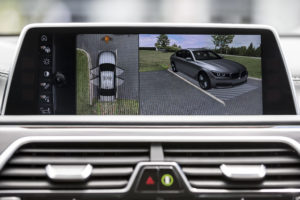
image courtesy BMW
Integral active steering lets the rear wheels turn too. It apparently makes highway driving smoother, but I most noticed the manoeuvrability while parking the big 7. Combined with a 360-degree view around the car, parking proved a cinch except for one nerve-wracking scenario involving an undersized condo parking spot with a motorcycle stored at the rear, another car parked right on the dividing line to my left and a cement support pillar to my right. The 7 kept beeping at me, showing me exactly where I was in relation to these other objects, as I gingerly parked safely and later exited the spot without a scratch. Reminder: this is a WIDE car.
Rather than have drivers wince in anticipation of upcoming potholes, expansion joints or other comfort-threatening road conditions, the 7 winces for them. “Wincing” might not be the right word. BMW likes the term “anticipatory” chassis control and Dynamic Damper Control. The camera located above the rearview mirror feeds information to the car about road irregularities immediately ahead so the 7 can respond to the road. These terms add up to Active Comfort Drive with Road Preview, a new feature on the 2016 7.
Good behaviour doesn’t just happen at speed or accelerating. Each time I took my foot off the accelerator pedal while approaching a stop sign or light, the 750i noticeably slowed down before I touched the brake pedal. Chalk up my noticing this to my habit of using engine braking to slow down to a stop (my own car is a five-speed manual), a habit that involves decelerating early.
I missed mentioning two screens earlier. The obvious one is the all-digital instrument cluster that can take on different appearances depending on the drive mode you choose and other factors.
The other is the heads-up display, a feature I hope becomes as ordinary as seatbelts and airbags. This HUD displays:
- current speed (this number turns red if it’s above the posted speed limit)
- the posted speed limit on the current road (so drivers have no excuse)
- upcoming turns from the navigation system
- cruise control information
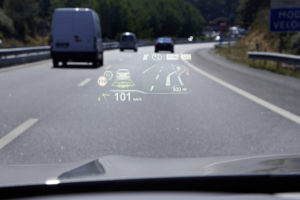
image courtesy BMW
Ride height can vary by as much as 30 mm. The 7 lowers itself 10mm in sport mode. You can raise it 20mm when driving on rough roads.
Pricing
The base MSRP of the 2016 BMW 750i xDrive is $113,900. My tester, with options, taxes and other charges, came to $132,600.